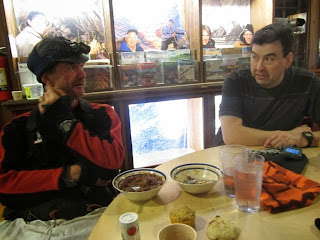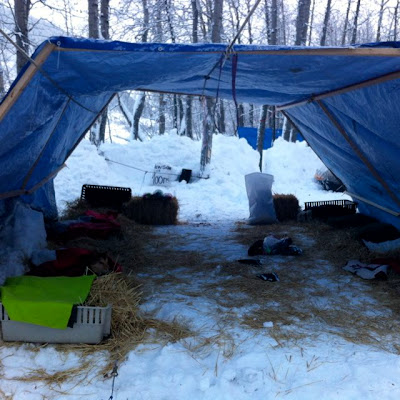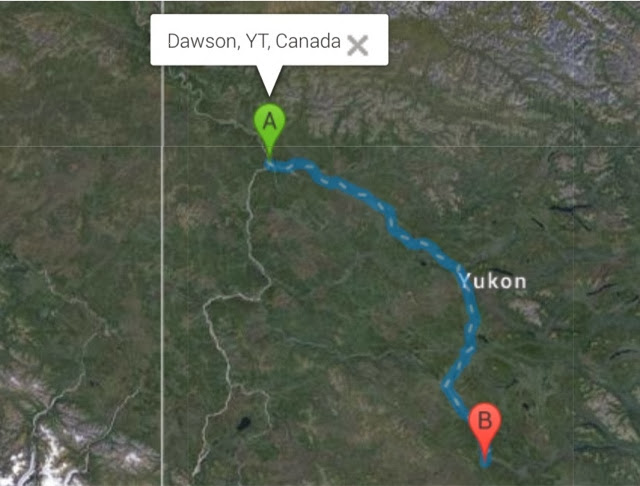The SPK Black Team arrive in Dawson.
YQ: Black Team Into Dawson
At 1.30 this morning (Yukon time) Allen and team arrived into Dawson! We were so excited to see them again and they looked fantastic crossing the line. Scruggs and Quito continue to lead the team.
Allen said the last part of the trail was cold (it was abut 20-25F below with a wind of perhaps 30 miles an hour) and when he came into the checkpoint he was decked out in his white Northern Outfitters wind jacket and pants and looked somewhat like the abominable snowman! It took him a few moments to find his way out of the jacket hood to speak to the checkers at the checkpoint.
I have video of the team coming in to the checkpoint which may take some time to upload but make sure you take a look at Chica still slamming her harness wanting to keep moving. It was remarkable how great they all looked, Allen included, after the big run from Eagle.
After the mandatory gear check Aliy took over the reins of the team and drove them over to the campsite that we had set up earlier in the day where Meghan was waiting with a warm meal, thick straw beds, fleece jackets and throw blankets and an Algyval massage. We’ll show you around the camp in the next day or so. Ray and I took Allen into the checkpoint, which doubles as the Dawson City Visitors Centre for the rest of the year, for two bowls of fabulous chilli, some water and a quick chat. He’s really happy to be here and looking forward to some rest then heading over to the dog camp to check on his team.

Ray catches up with Allen over two bowls of chilli
Allen told us a little about the trail… from Slaven’s Cabin to Eagle was the worst Allen had ever seen it. The area had experienced the high temperatures recently felt all over Alaska and the trail had melted and become treacherous. He said they were going over sections of glare-ice 5-10 miles at a time. There’s not much trail breakers can do about that and they had done the best job they could. He did say though that the harder the trail was the harder the dogs pulled!
The trail from Eagle to Dawson, however, was the best he’d ever seen which is why they were going along at such a good clip. He stopped for an hour at 40-mile Cabin where he fed the team a kibble meal and several snacks and they got to rest for a while. He said that was a great move as they perked up and looked even better after that.
What happens now is we handlers step in to care for the dogs, do any repairs to the sled, launder clothes, order steaks – whatever we need to to get this team ready to head back on the trail in 36 hours. This is where we can make a real contribution to the outcome of the race and we are excited and ready! Well… maybe we will try to get a little sleep first… then we’ll be ready!
YQ: Handlers Win
Aliy, Ray, Meghan and Moira arrived in Dawson minutes ago. Allen is still about 30 miles out. The camp should be complete and comfortable when the Black Team arrives. Probably no naps for the crew though! Hope they slept on route in the truck!
YQ300: Picture Perfect!
One last tip of the hat to the YQ300 Champs… Is this picture at the finish perfect, or what?

(Photo by permission of Scott Chesney)
As our attention now shifts to focus exclusively on Allen and the SPK Black Team, the “Yukon Trio” are charging down the river toward Dawson. Brent Sass remains in the lead and the spacing looks to be about the same as it’s been since they all left Eagle.
These are obviously very well matched teams, and that bodes well for a very exciting second half of the race!
We hope to bring you some great “live” coverage soon… Stay tuned!
Q&A: Yukon Quest vs. Iditarod
Although the Yukon Quest and the Iditarod are similar in their 1,000 mile length, there are a number of differences between them.
First of all, the Yukon Quest runs a month earlier than the Iditarod, so it’s generally darker and colder for the teams. It also crosses territory that is more remote than the Iditarod, and many say it is more rugged. The dogs probably don’t care about this (or even know the difference) but it can weigh heavily on the mushers’ minds to be so far from anyplace. Stress adds up in a long race, and that’s a mental factor to contend with.
As a result of its remoteness, the Yukon Quest has fewer than half the number of checkpoints on Iditarod, and many of them aren’t as well established. That makes for substantially longer runs between resupply opportunities and forces teams to carry more weight, often including bales of hay.
That explains why some of the sleds you see in YQ photos look so much bigger and bulkier than their counterparts on Iditarod. With all the excess gear that’s sometimes lashed on top of the sled bags, they can look a little bit like the Beverly Hillbillies!
Another significant difference is the YQ’s mandatory 36-hour layover in Dawson. Unlike the Iditarod in which mushers have several checkpoints to choose from for taking their mandatory 24-hour layover, all YQ teams must make their long layover in Dawson City. Although that obviously has an impact on race strategy and run/rest schedules, teams can at least plan for it well in advance.
On the plus side, the teams get an extra 12-hours of rest during their YQ layover versus their Iditarod 24-hour stop. Also an advantage, the YQ allows for virtually unrestricted assistance to be given to mushers by their support crews. Once Allen gets to Dawson, he can literally “hand over the keys” to the crew and they will take total care of his dogs for the duration of the break.
While Allen is sleeping, eating, sleeping again and eating more, the dogs will be doing the same in a very comfortable, tarp-covered and straw-lined campsite that has been fully prepared in advance by the crew. They dogs will also get frequent massages and stretch-out walks. The crew basically provide the dogs with round-the-clock room service and personal pampering!
Here are a few photos of last year’s campsite:
When the layover is complete, the crew will harness and bootie the team in time for Allen — hopefully fully rested, refreshed and refueled! — to jump on the runners and move them out. As soon as the team is out of sight, the crew will do a thorough clean-up of the campsite, load all the gear in the truck and resume their own race to stay ahead of the team to the finish line!
I’m sure an actual YQ/Iditarod musher could tell you a lot more about the differences between the races, but I hope this has at least given you the gist of it… Stay tuned!
YQ: The Race to Dawson is On!
You may think I’m talking about the race between Allen, Brent and Hugh, but NO!…
I’m talking about the race between the Black Team and the handlers!
As Allen and the dogs approach 40 Mile cabin, about 44 miles northwest of Dawson, Aliy, Ray, Meghan and Moira are zooming through the Yukon Territory in “Hollywood” (the new kennel truck) from the southeast, trying to reach Dawson and get the camp set up BEFORE the team arrives.
They are about 220 miles from Dawson. The map program says that’s about 5 1/2 hours. The Aliy “program” says about 7 for Allen and the Black Team. Yikes, that’s close!
The trail change that eliminated American Summit is making it VERY difficult for the handlers. Not only is the race time shorter by the length of the 50 mile run, but also from the lack of the necessary rest after the summit! Race safely, my family.
YQ300: Mile 101 Red Team video
Here is some footage of Aliy and her Red team pulling into and leaving Mile 101 checkpoint.
When she arrives you can clearly see the official “checker” sign her in then check she is carrying all her mandatory equipment in the sled: axe, sleeping bag, snow shoes, dog food cooker and fuel and the vet book which holds all the veterinary notes about each dog in the team. If a musher is missing any equipment there are time or monetary penalties that could change the result of the race!
Q&A: 300 Miles vs. 1,000 Miles
Several of you have asked about the difference, besides the distance, between a 300 mile race and a 1,000 mile race. It’s a complex question for which there are probably as many answers as people you ask. For what it’s worth, here’s my view on the subject:
There are three basic criteria for evaluating sled dogs: Ability, Attitude and Appetite.
Ability simply refers to the their speed, strength, stamina and agility. Obviously, these are the fundamental athletic traits you want in racing sled dogs.
Attitude refers to their enthusiasm, initiative, tenacity and resilience. How much they love to run, whether they’re always eager to get up and go, how hard they work through challenges and how quickly they bounce back from difficulties.
Appetite is all about how well they eat. Will they eat anywhere, everywhere, anytime and everytime. At the most basic level, sled dogs are energy conversion machines that turn food into power. They’re like diesel motors: If you can keep putting fuel in the tank, they’ll keep cranking out the power. To do that, they have to eat, no matter how tired they are, how tough the conditions or how bad the weather.
A fascinating aspect of sled dog racing is how much the priority of these attributes shifts depending on the length of a race:
For short races, ability is everything: Run faster than the other teams, then go home to your dog house for dinner and a movie.
In mid-distance races like the YQ300, teams are on the trail for a couple of days and are likely to face larger challenges of conditions and fatigue. Thus, their ability must be supported by their attitude and appetite.
For long-distance races like the YQ1000, attitude and appetite actually take precedence over ability. Even a mediocre athlete who goes the distance in harness is far more valuable than a talented dog who quits or loses weight and gets dropped from the team.
It is very rare for a dog to be superb in all three criteria. For example, Dingle has a solid attitude and a healthy appetite, but he’s not very fast. Rambler has ability and attitude, but he’s sometimes fussy about eating. Beemer has ability and appetite, but he occasionally gets a little “soft” in the head. Quito is as close to being a perfect dog as there is.
Despite these minor differences, it’s the overall, very robust combination of all three attributes that makes the dogs of SP Kennel superstars. The broad latitude of distances in which they are highly competitive is testament to their genetics, training and care. They probably won’t win a 20-mile sprint race, but if it’s anything between 100 and 1,000 miles they’ll be in the hunt!
Everything I’ve written above is also true about the mushers. As races get longer, the complexity, hardship and fatigue go up exponentially. Short races are relatively easy to plan, execute and endure. Long-distance races require monumental preparation, diligent and determined strategy, and epic physical and mental stamina.
The dogs’ attitude resonates with the musher’s, so confidence, focus and grit must be maintained over every single mile. If a musher gets down or fatigued, the dogs are sure to follow suit. Aliy and Allen are champs because of their mental, physical, emotional and psychic prowess.
Last but certainly not least, the same is all true for the Crew: The many miles traveled over desolate roads. The hours and hours of being tired, cold, hungry and bored while waiting for a team, then jumping into total action on a moment’s notice. Pampering dropped dogs when all you want to do is curl up and die.
Basically, the difference between a 300 mile race and a 1,000 mile race is like the difference between running a mile and running a marathon… You’ve got to have ability for both, but you need attitude and appetite to go the distance.











